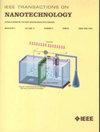巧妙利用具有角点的独特 GeSn TFET 的电气特性来传感 S 蛋白生物标记物
IF 2.1
4区 工程技术
Q3 ENGINEERING, ELECTRICAL & ELECTRONIC
引用次数: 0
摘要
本文首次提出了一种独特的基于 Ge(1-x)Snx 合金的 TFET 传感器,该传感器在通道中特意设置了一个角点,用于成功检测 S 蛋白这种重要的生物标志物。通过对实验中实现的母 GeSn TFET 器件进行校准,验证了我们的模拟方案。根据一组性能指标--P 反应性和 P 灵敏度--沟道外延层厚度 (CHepi) 的函数,对所提出的传感器件的性能进行了深入研究。然后,通过改变拟议传感器中 Ge(1-x)Snx 的摩尔分数,根据上述性能指标以及称为动态灵敏度的额外独特指标对传感性能进行了研究。有趣的是,我们发现在纯电子领域(数字或模拟)最合适的设备在传感领域却最不合适,反之亦然。这就避免了在未进行适当调查的情况下,盲目选择在纯电子领域性能更强的器件用于传感目的。经过深入分析,我们发现 CHepi = 10 nm 的拟议传感器已发展成为最优化的传感器设备,而分子分数的选择仍与具体应用有关。此外,最终优化的传感器在处理实时位置变化方面(即使是由于 S 蛋白分子的排斥立体效应)表现出相当好的性能,这导致了部分杂交问题。本文章由计算机程序翻译,如有差异,请以英文原文为准。
A Judicious Exploitation of Electrical Characteristics of a Unique GeSn TFET With Corner-Point for Sensing S-Protein Biomarker
In this paper, for the first time, a unique Ge
(1-x)
Sn
x
alloy-based TFET sensor with a deliberate corner-point in the channel has been proposed for successful detection of S-protein, a significant biomarker. After the validation of our simulation scheme through a process of calibration of an experimentally realized mother GeSn TFET device, the same is turned into the proposed sensor device by suitably creating nanogap cavity in it. The performance of the proposed sensor device has been thoroughly investigated as a function of channel epilayer thickness (CH
epi
) in terms of a set of performance metrics – P-responsivity and P-sensitivity. Then, by varying the mole-fraction of Ge
(1-x)
Sn
x
in the proposed sensor, the sensing performance has been studied in terms of the aforementioned performance metrics, along with an additional unique metric known as dynamic sensitivity. Interestingly, it has been observed that the most suitable device in pure electronic domain (digital or analog) is the least suited in sensing domain and vice-versa. This forbids the tendency of blind-picking of device with enhanced performance in pure electronic domain for sensing purpose as well without proper investigation. After a thorough analysis, it is observed that the proposed sensor with CH
epi
= 10 nm has evolved as the most optimized sensor device while the choice of mole-fraction remains application specific. Also, the ultimately optimized sensor shows a fairly good performance in dealing with the real-time position variability aspect (even if it is due to the repulsive steric effects of S-protein molecules) which results in a partial hybridization issue.
求助全文
通过发布文献求助,成功后即可免费获取论文全文。
去求助
来源期刊

IEEE Transactions on Nanotechnology
工程技术-材料科学:综合
CiteScore
4.80
自引率
8.30%
发文量
74
审稿时长
8.3 months
期刊介绍:
The IEEE Transactions on Nanotechnology is devoted to the publication of manuscripts of archival value in the general area of nanotechnology, which is rapidly emerging as one of the fastest growing and most promising new technological developments for the next generation and beyond.
 求助内容:
求助内容: 应助结果提醒方式:
应助结果提醒方式:


